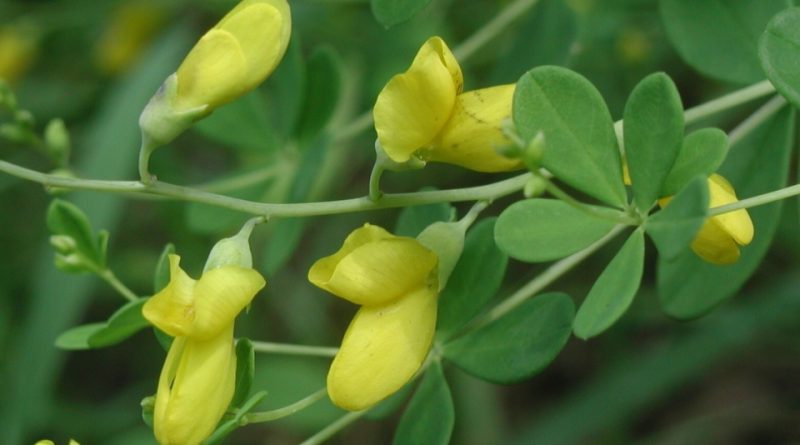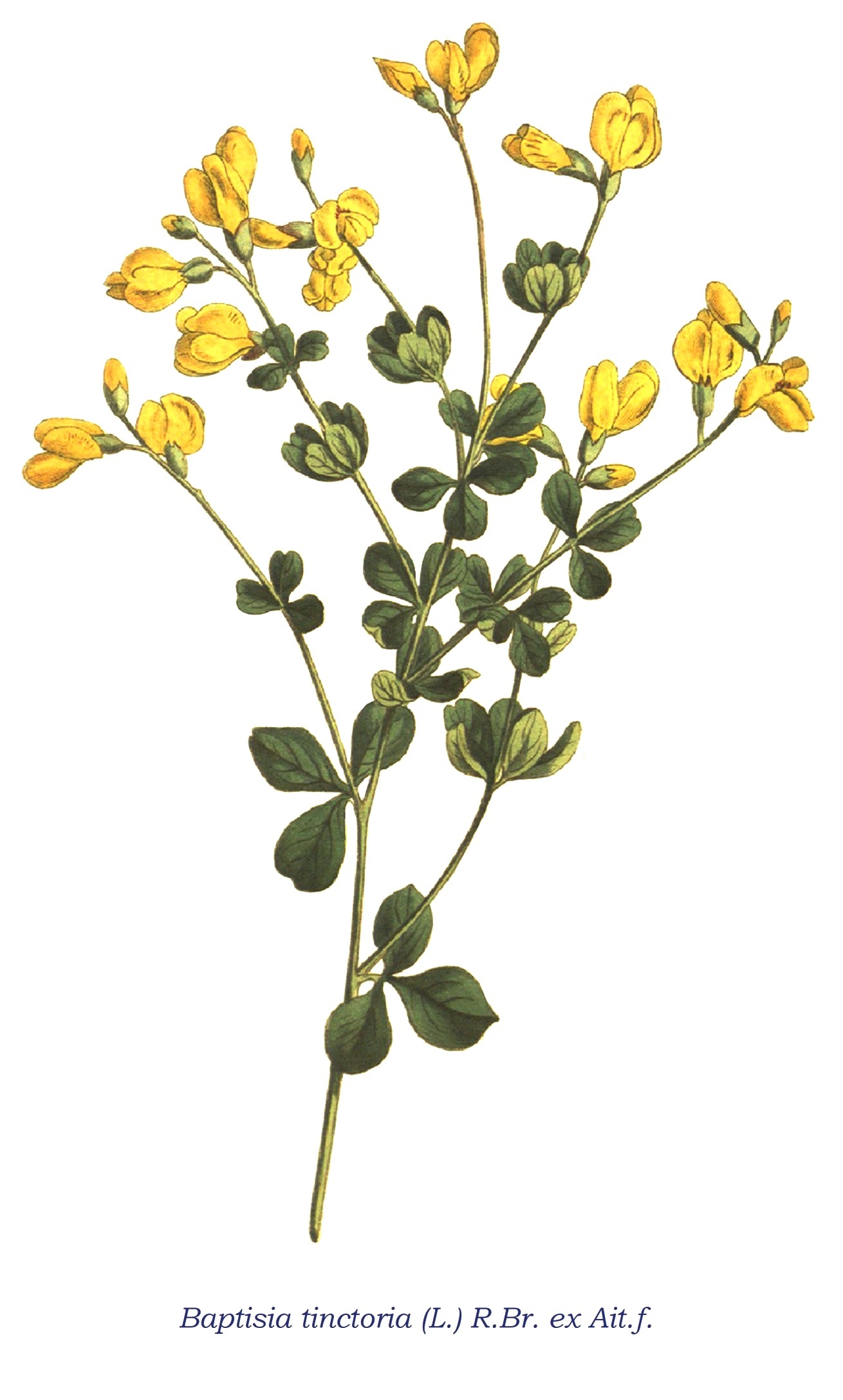Baptisia tinctoria
Baptisia tinctoria
The wild indigo (Baptisia tinctoria (L.) R.Br. ex Ait.f.) is a perennial herbaceous species of the Fabaceae family.
Systematics –
From the systematic point of view it belongs to the Eukaryota Domain, United Plantae, Magnoliophyta Division, Magnoliopsida Class, Fabales Order, Fabaceae Family and therefore to the genus Baptisia and to the species B. tinctoria
Etymology –
The term Baptisia of the genus comes from the Latin neo and derived from the Greek baptw = tingo, to baptize, to immerse, in the sense of dyeing, for the use of this plant used as an indigo dye.
The specific epithet tinctoria comes from tíngo dye: used to dye fabrics.
Geographical Distribution and Habitat –
Wild indigo is a plant native to eastern North America, where it grows mainly west of Minnesota and south of Florida.
This plant has become rare in some areas of origin and is protected in some states. Its presence is threatened in Kentucky, while in Maine it is considered to be in danger. Its habitat is that of dry meadows and open woodlands.
Description –
The Baptisia tinctoria is a herbaceous plant consisting of several stems that can reach a height of 0.60 – 1 m in height.
The leaves are green-silver in color, deeply trilobed and about 1 -1.5 cm long.
The flowers are yellow, with the typical papilionaceous conformation and 1.3 – 7 cm long.
The flowers bloom in the period between May and September.
Cultivation –
The wild indigo is a perennial herbaceous species that grows spontaneously in dry meadows or even in open forest environments. It could be grown by spreading the seeds in annual culture and to extract its active ingredients.
Uses and Traditions –
Baptisia tinctoria is a plant used in its areas of origin for a long time.
In the arid areas of origin the Native Americans of the Creek tribe employed this plant by boiling the roots of Baptisia in water and administered the decoction internally and externally to tired and debilitated children, apparently about to fall ill. The Mohicans made a mush from the root macerated in water and used it to wet cuts and wounds.
The American settlers applied it to the sores, ulcers and eczema for its astringent and antiseptic properties and internally for scarlet fever and typhus.
Baptisia tinctoria contains small amounts of alkaloids, such as cytisine (which is the main cause of the poisonousness of some legumes like Spanish broom) and some isoflavone heterosides, such as: isobaptigenina and baptigenina.
The mother tincture is prepared with the fresh underground part.
The wild indigo was introduced for the first time in homeopathy in 1857 and was used mainly in North America as a colagogue.
Allen indicated twelve pathogenetic sources: the number of symptoms, however, is very small, and includes headaches with a hot face, difficulty concentrating, agitation, eye pain, throat pain, yellowish patina on the tongue, pain in the abdominal region, with particular involvement of the hepatobiliary area (liver), sensitivity of the iliac fossa and diarrhea.
To say, moreover, that in the past the Baptisia tinctoria was used also in the case of infectious syndrome of a certain gravity, as, even, typhoid fever.
The drug used is the root and the main active ingredients are: cytisine and baptisine glycoside.
No toxicity is reported for this plant and no contraindication to normal therapeutic doses except individual hypersensitivity.
The organs affected by the phytotherapy action are:
– pharyngeal-gold cable;
– gall bladder and biliary tract;
– pharynx and upper airway;
– liver and biliary tract;
– organs and / or tissues of various parts of the body;
– immune system;
– stomach.
The properties are:
– antiseptic;
– colagogo;
– gold-pharyngeal astringent mouthwash;
– dermopurifying and dermoprotective;
the indications are for:
– dermatosis;
– ulcerative pharyngitis;
– fever or hyperthermia;
– fevers (infectious and septic);
– hepatobiliary insufficiency and intoxication of the liver;
– ulcer (peptic – gastric – duodenal).
In phytotherapy, Baptisia is used for:
– especially bacterial infections;
– ulcers and sores;
– tonsillitis;
– dysentery;
– gingivitis;
– respiratory infections;
– nervous breakdown;
– stimulate the immune system;
– swollen lymphatic glands;
– blood poisoning and septicemia.
The use of this plant as a dye to replace the true indigo (Indigofera tinctoria) is also frequent. It tends, from dry, to assume an almost blue / black color.
The leaves are eaten by some lepidopteran caterpillars, for example the Automeris io moth.
Preparation Mode –
For the use of the active ingredients of this plant the roots can be boiled in water using the decoction for both internal and external use.
It is also possible to use mash obtained from the roots macerated in water to wet cuts and wounds but also for ulcers and eczema and for its astringent and antiseptic properties and internally for scarlet fever and typhoid.
Obviously the direct use of homemade products is never recommended and always use the medical advice for any use.
Guido Bissanti
Sources
– Acta Plantarum – Flora of the Italian Regions.
– Wikipedia, the free encyclopedia.
– Treben M., 2000. Health from the Pharmacy of the Lord, Advice and experiences with medicinal herbs, Ennsthaler Editore
– Pignatti S., 1982. Flora of Italy, Edagricole, Bologna.
– Conti F., Abbate G., Alessandrini A., Blasi C. (edited by), 2005. An annotated checklist of the Italian vascular flora, Palombi Editore.
Attention: Pharmaceutical applications and food uses are indicated for informational purposes only, do not in any way represent a medical prescription; therefore no responsibility is assumed for their use for curative, aesthetic or food purposes.


